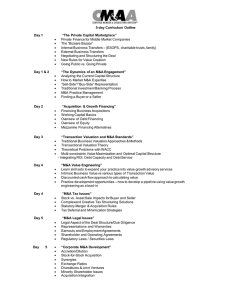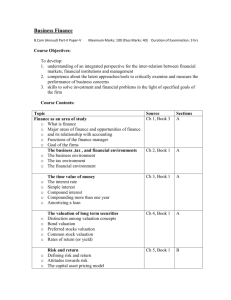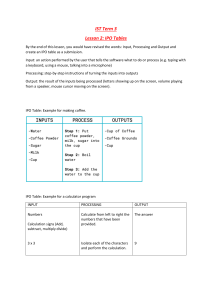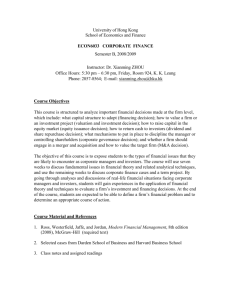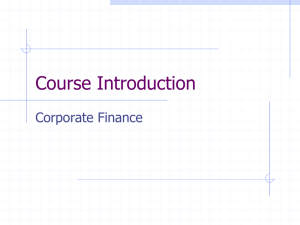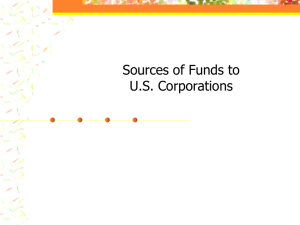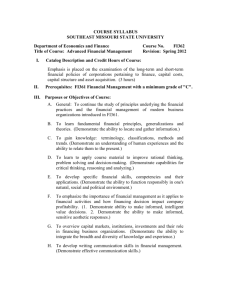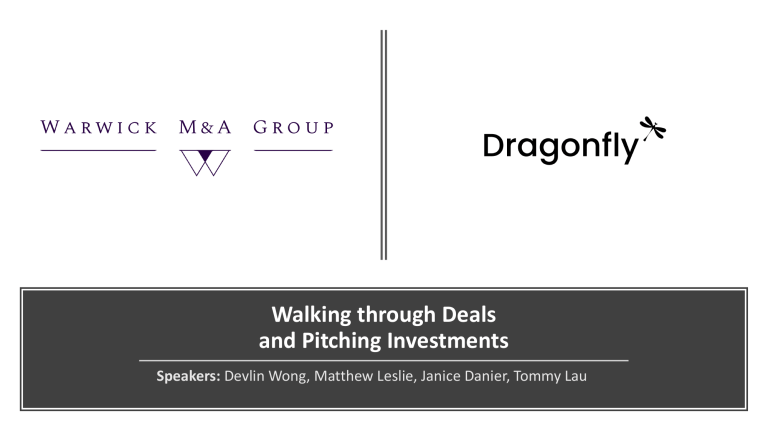
Walking through Deals and Pitching Investments Speakers: Devlin Wong, Matthew Leslie, Janice Danier, Tommy Lau X Discussing Deals - Walking through a Strategic M&A General Structure of a Strategic M&A Discussion Transaction Summary • Basic information: buyer/seller, type of transaction, deal value, purchase price, financial advisors • Interesting facts: e.g. first large-scale acquisition by Company X Company Overviews Product/service offering, key financials, market position and share, public or private company • Focus on company you advised, more detail about recent performance and business model Deal Rationale • Motivation for M&A: e.g. expand product portfolio, geographic diversification, access new technologies, revenue/cost synergies • Greater financial evidence to support reasons Bid Process (Optional) • Notable events (if any), key buyers/sellers in auction process • Buy-side vs sell-side considerations, why particular buyer/seller Financing Form of consideration: cash vs debt vs equity Result and Opinion • Market reaction (if available), key figures of the new entity • Why deal interested you, was valuation fair, future outlook, risks • Good understanding of valuation, ‘house’ view on the deal Potential Follow-Up Questions • Synergies: dive deeper into the potential cost and revenue synergies realized • Strategic alternatives: evaluate the other strategic alternatives the company could have AB InBev’s $11bn Sale of Australian Unit to Asahi • Transaction summary: 19/07/19 AB InBev, the largest global brewing company, sells its Australian business (Carlton & United Breweries) to Asahi for an all-cash consideration of $11.3bn • Lazard advised AB InBev, while Rothschild advised Asahi • Sale comes after failed IPO of AB InBev’s Asian business • AB InBev rationale: running out of options to reduce high debt • Asahi rationale: weak domestic demand, overseas expansion • Financing: Asahi raised $2bn in equity and took out an additional loan for an all-cash consideration • Result: AB InBev’s shares rose 4% in response • Deal made Asahi 3rd largest brewing company in the world • Opinion: proves the importance of understanding deal risks • Valuation seems high: implies EBITDA multiple of 14.9x – high for the industry, and Asahi expected to have more negotiating power Other Tips pursued; justify why other buyers (if any) were eliminated from the bid process • Deeper fundamental analysis: if company is public, expect deeper dive into financials • Valuation: if you were the financial advisor, how would you go about valuing the firm? Read through the investor presentations for deal rationale Context is key – know market background and firm history X Discussing Deals - Walking through LBOs Key Differences with Discussing Strategic M&A Transactions: Focus on why target is an ideal LBO Candidate: PE firms aim to generate an attractive return rather than realize synergies Expect more rigorous follow-up questions on company operations: PE firms generally aim to “buy-and-build” the target company Thorough understanding of the financing structure (if available) PE firms utilize highly customized and sophisticated financing structures • Characteristics of an Attractive LBO Candidate: strong and predictable cash, low CAPEX, growth and cost-cutting potential, heavy asset base, low debt • Common characteristics for take-private targets: undervalued, high turnaround potential, portfolio breakup of large conglomerates • Take-private transaction: expect more rigorous questions on their financial statements • Examples: key revenue and cost drivers, current margins and margin growth potential, evaluation of CAPEX requirements, current capital structure • Private takeover: not expected to answer these questions but need to have an educated guess • Financing structure heavily affects the success of the transaction and buyer’s returns • Understanding of bank debt (i.e. term loans and revolving credit facilities, bridge loans, syndicated loans), HY bonds, and mezzanine financing would be helpful If you have prior LBO modelling / PE fund valuation experience, you may be asked to dive deep into the financial models. In this case, thorough understanding of LBO concepts are required: a) drivers of IRR, b) exit strategies, c) financing structure, d) LBO return attribution: EV expansion, repayment of debt, multiple expansion X Discussing Deals - Walking through an IPO General Structure of an IPO Discussion Budweiser $5B IPO Sample – Key Commentary Transaction Summary • Basic information: IPO date, deal proceeds, amount of shares sold, offering price per share • Interesting facts: e.g. largest deal in Y sector in HK Company Overview Product and/or service offering, key financials, end markets, market position and share Financing Rationale Use of proceeds – e.g. pay down debt, acquisition financing • IPO Rationale: begin deal-making in Asia, pay down parent’s $100B debt load Market Timing Macroeconomic health, equity capital market sentiment, industry sentiment – always tie back to investor appetite • Poor equity market sentiment: HK protests + US-China tensions • Industry premiumization: high Chinese beer valuations Share Allocation, Execution, Valuation • Cornerstone and other notable investors, greenshoe option • Investor targeting and share allocation; marketing and bookbuilding dynamics • Greater understanding of valuation (mainly trading Comps) • Greenshoe option exercised: additional $750M raised • GIC participated as a cornerstone investor • Valuation: 18x forward 2020 EV/EBITDA based on $45B EV – slight discount compared to Chinese market leaders Result and Opinion • Was IPO successful – capital raised, oversubscription, aftermarket performance • Why the IPO interested you, future company outlook, risks • IPO success: $5B raised, 2.6x oversubscription, up 1.5% at opening • Business outlook: focus on premium brands, expand into other Asian economies Potential Follow-Up Questions: • • On 9/30/2019, Budweiser underwent a $5B IPO to list on the HKSE. 1.67B shares representing 15% of shares outstanding were sold at HK$27/share. MS and JPM were lead sponsors. • Largest 2019 IPO in HK, 2nd largest IPO globally at that time • First attempt to go public failed due to various reasons Other Tips Qualitative business questions: company’s growth potential and strategy, key competitors, industry landscape and trends • Markets: market conditions during time of IPO, key geopolitical / economic events • Alternative financing methods: evaluation of equity, debt, and loan financing tradeoffs • Valuation: key comps and their respective valuation multiples Read through the Prospectus for more detailed insights Holistic thinking is required to address follow-up questions Discussing Deals – Finishing Remarks General Tips Rule of thumb: • Prepare 2 deals in detail (preferably one advised by the bank you are interviewing for) • Prepare 2 other deals on a high-level Prepare a couple ‘potential deals’– follow the suggested structures to justify why the M&A / IPO makes sense How to find deals: MergerLinks, MergerSight, Warwick M&A Group reports, Bloomberg/WSJ/FT/Thomson Reuters Deal Section Understand the current M&A / Capital Markets landscape: to be an expert in a deal, you need to understand the high-level and sector-specific trends which shape the dynamics of the deal Think critically from a banker’s perspective: How would you advise your client? What key factors would you take into consideration? Common Mistakes made by Candidates 1 Disorganized structure 2 Focusing on the wrong aspects 3 Information/statistics overload X Pitching Investments – Stock Pitch General Structure of a Stock Pitch Buy recommendation on Johnson & Johnson (JNJ) Investment Theses • One sentence recommendation: buy/ sell, company name, current price, target price, investment horizon • Long investment opportunity on Johnson & Johnson (JNJ), at its current price of 140, targeting a 5% upside over 6-12 months Company and Industry Overview • Company: product/ service offering, geographical coverage, revenue drivers, market positioning, long-term initiatives • Industry: secular trends in the industry, competitive landscape Catalysts • Industry vs. stock specific catalysts: having both are desirable, but stock specific catalysts are a must • Soft vs hard: hard catalysts are ideal but not common • JNJ: big player in the healthcare sector covering 3 segments: pharma, medical devices and consumer (~$388B market cap) • Healthcare: high growth given demographic shifts in the US and increasing incidents of chronic diseases Risks • Upcoming events or trends that might dampen growth (for buy recommendations) or spur growth (for short recommendations) • The company’s risk management strategy (if any) • Hedging alternatives (optional) Valuation • Comparison against comparables using appropriate multiples Conclusion • Reiterate investment theses and projected upside (in %) Potential Follow-Up Questions • • Integration of AI and big data applications in the healthcare sector • JNJ’s ongoing clinical trials set to be completed in 6 months • Expected synergistic benefits from recent acquisition of a European pharma company • Risks of clinical trial failures, difficulty in integrating technology changes to current operation systems • Valuation seems cheap: EV/ Sales ratio of 4.95x for JNJ is much lower compared to the peer group’s 5.35x Other Tips Company & industry: company’s business model, advantages over competitors, debt and leverage levels, industry positioning, etc. • Target price: how did you arrive at this target price? • Valuation: why is this multiple appropriate? Is the potential upside priced in? • Risks: what’s the downside in the worst case scenario? Any hedging alternatives? Start by choosing an industry of interest / familiarity, then pick a few names to look into Structure and relevancy is perhaps more important than the actual stock X Pitching Investments – FICC (Credit/Macro) Trade Ideas Overview + General Structure Trades • Either a pairs/carry trade, derivative strategies or outright long/short Thesis & Overview • Quick Walkthrough: name, trade structure, price, target, stoploss (if any) etc. (Bonus: Sizing, Leverage, Target Clients etc.) Catalysts • Highlight mispricing and why the subject will trend towards fair value (and why now?) • Macro: macro events or economic data release • Credit: company-specific events, industry wide events • Relative Value Risks • Maximum downside • Hedging exposure(s) • Angle: Risks exist, but effect immaterial/ view is that company can mitigate such risks due to x reasons) or that risk is “priced in” Conclusion • Reiterate ideas and open for questions Potential Follow-Up Questions • Ronshine China (RONXIN) Fundamental Long Trade • Attractive deleveraging story: -28.3% YoY net gearing ratio change (3rd largest decrease among all China property HY names); ~80% is well below industry average of 103% • Solid debt servicing capabilities: Debt/EBITDA 11.16x -> 6.08x YoY, Current ratio 1.4x • Changes reflected in uptick in credit rating: Moody’s upgraded from B2 to B1 positive YoY • Higher coupon range (6.95% - 10.5%) relative to single-B peers coupled with a safer credit profile • Industry risks due to tightening regulatory oversight: NDRC/PBoC directive of “Housing for living, not speculating”, but this favors RONXIN since industry credit profiles will diverge yet RONXIN falls on the safer side of credit • In summary: Commitment to deleveraging, robust debt servicing, improving credit profile & high coupon -> RONXIN looks attractive Other Tips Trade logic: How are you certain this catalyst will materialize? What happens to the trade if X event does not happen? • Timing: Why do this trade now? Why not after X event happens? • Technicals: What is [metric] and why is it important? • Execution: What’s your target? Stop-gain/Stop-loss? Don’t just reel off numbers, look for “organic” catalysts and structure your view accordingly Can start off by reading “Opinions”, subscribe to newsletters, websites Pitching Investments – Finishing Remarks Common Mistakes made by Candidates 1 Taking too long throughout the overall pitch ( >3 mins) 2 Not stating the investment thesis clearly 3 Blurting out all the information General Tips Rule of thumb: • Prepare 3 stock pitches at the very minimum, across at least 2 sectors • Combination of buys and sells Be smart about what you pitch: avoid big names, pitch Asian stocks if you’re interviewing for Asia, UK/EU stocks for London, etc. Stick with the basics: Don’t pitch overly complicated derivative products if you can’t handle the follow up questions Be reasonable with your recommendation: don’t say that you’re expecting a 100% upside, you’ll get challenged Practice your delivery: choose your words wisely, don’t memorize a script word by word
